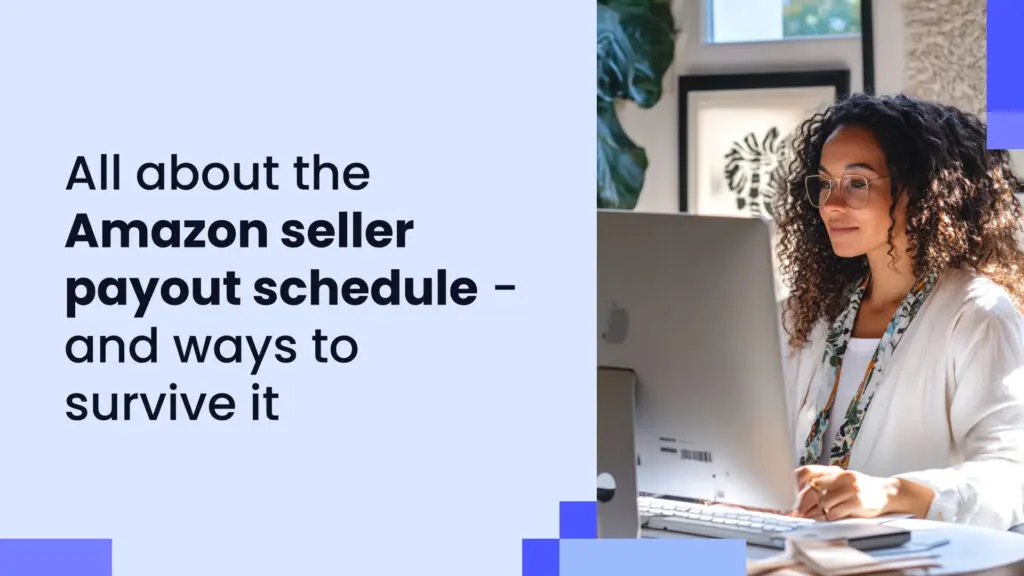- What are Amazon seller payouts?
- How long does it take to get your Amazon payments?
- How do Amazon seller payouts work?
- Can you get your Amazon payouts faster?
- What is an Amazon account level reserve?
- Amazon seller payout reports
- How can you succeed between Amazon payouts?
- Funding to tide you over until your next payout
As an eCommerce business owner, you probably know how difficult it can be to manage a budget. Balancing expenses and income is a lot of work, especially if you don’t receive your income right away. This is a challenge faced by many Amazon sellers who struggle with their Amazon payout schedule.
Selling on Amazon has its pros and cons. It’s wonderful to see that your goods are selling, but waiting for payouts to arrive can mean you don’t have the cash on hand to pay bills on time. This can lead to penalties and even irritated customers.
Banks don’t care about your payment schedule, and they will charge you for late payments. When you don’t have enough cash flow, you may lack funds for inventory, which leads to stockouts, and can have vast consequences on your business.
If you’re an Amazon seller, you know how frustrating it can be to wait for those payouts. Your expenses don’t stop while the money is processed, so you need to know how to plan ahead and grow even without your payouts in hand. We’ll discuss what you need to know about Amazon payouts, so your eCommerce business can thrive.
What are Amazon seller payouts?
Amazon has its own online payment processing system that it uses to pay sellers on the platform. It records purchases from customers, collects payments, and then holds the funds for a period of time. This is done in order to leave plenty of time for refunds, disputes, and other claims before depositing revenue in your bank account. It helps keep your customers happy and ensures that this aspect of customer service runs smoothly.
However, this delay means that you, the seller, have to wait to receive your payments. In fact, Amazon puts funds from most transactions on hold for a set period of time. After this time has passed, you receive your revenue according to Amazon’s payout schedule, with delays for processing time.
Amazon is a great choice for eCommerce sellers for many reasons. It’s the largest online retailer in the United States, giving you access to a huge market of customers who are already prepared to make a purchase. Visitors to Amazon are looking to buy, unlike when they visit social media or even Google. Amazon also has lots of options for sellers; you can choose from various business models and advertising strategies on their platform. In short, it’s a beneficial place to be a seller. However, there are a number of drawbacks that come with this payout schedule.
How long does it take to get your Amazon payments?
The length of time it takes to get your payouts depends on whether you have a professional account or if you’re an individual seller. Professional accounts receive their payouts bi-weekly, or every 14 days, while individual sellers get theirs every week. You can even apply for manual disbursement once every twenty four hours, and afterward you’ll get your funds within five business days. However, there are some processing regulations that can extend these given periods of time.
Subscribe to the eCommerce newsletter for
top industry insights
It’s vital to note that Amazon fees can be deducted from your balance at any time, so if you were expecting more out of your payout, then look for that charge on the summary. We’ll go over the details of how Amazon payouts work, so you can better prepare your budget.
How do Amazon seller payouts work?
Your positive balances are delivered via ACH transfer or electronic fund. Any negative balances will be automatically deducted using the credit card you keep on file. Now, here’s where you can get frustrating for individual sellers. Every transaction is put on hold, and if no issues arise, the money is released on the next disbursement date. Issues that can delay or stop you from receiving your payouts include the customer not receiving the item, lost packages, or returns. Once the customer gets their package, they have one week to make a return before the funds are finally released to the seller. The seller can then transfer the funds to their bank.
As you can see, the process takes some time. That doesn’t include Amazon processing time once they release the funds to you, which takes another three and five business days. And your payout date is determined by the day you signed up on Seller Central. It could potentially take up to one month to receive your money from the date of purchase. It’s not uncommon to wait this long for your payouts, so it’s important to plan accordingly. It’s also important to note that payouts cannot be made to credit cards or PayPal accounts.
Can you get your Amazon payouts faster?
Amazon does offer services that allow you to get paid fast, which means you can get your payouts on the 15th of every month. They use your invoiced orders to credit your account. The catch is that you’ll have to pay a 1.5% processing fee, which is applied to all sales. This fee is in addition to the other fees you’ve already agreed to pay as an Amazon seller. So, if you don’t need the money right away, you might want to wait for your payouts and save yourself some money.
In addition, Amazon has a new service called Express Payout that allows certain sellers to bypass the 3-5 day processing time and receive payments within 24 hours. This service is available to sellers in the United States that use a US bank account and have transactions of $ million or less. These Amazon sellers can use Express Payout for free until September 2023, and then it will cost 50 cents per transaction.
What is an Amazon account level reserve?
It’s important to know that Amazon sets aside a portion of your funds for customer claims and chargebacks. This ensures that there is enough money in the system to cover these critical costs.
Before there was a holding period, sellers would sell large quantities of items with long delivery times. Some scammers took advantage of this situation, faking sales and collecting payments without ever sending products to customers. When they didn’t hold on to the payments, Amazon was too late to catch scams before the fake seller left the platform with their stolen cash.
Today, there are several reasons Amazon may place an account level reserve on your account. If you notice such a reserve on your account, it can take twice as long to get paid. Some reasons may include a delay in delivery confirmation, poor performance, sudden account changes, or claims filed against you. The main way to avoid a reserve is to make sure your customers are happy and be transparent about all costs, shipping times, and product availability.
Might also interest you:
- Maximize your Amazon store’s growth: A guide to using search and compare pages
- How and why running out of stock hurts your Amazon ranking
- Expert cash flow management tips for maximizing profits on Amazon
Amazon seller payout reports
Amazon provides sellers with a payout report. This includes four main sections that you can use for your own records and to understand your current business health. Your payout report will help you determine where you need to make changes, so you can increase payout amounts.
The sections include your income, expenses, transfers, and sales tax. You can imagine that the list of transactions might be long and confusing, but they provide a helpful summary section that explains all your totals. Use these figures to stay on top of your sales and budget accordingly. Amazon is always there to help if you have questions, too.
How can you succeed between Amazon payouts?
You now know when you’re going to get your Amazon payout and what to expect when you do, but how can you hold your business over until you get your hard-earned cash? There are many expenses that go into running an eCommerce business. How you manage them is what makes or breaks your business. That’s why it’s important to know how to tackle them, even when you don’t have the proper funds in hand. Let’s discuss the best ways to survive the waiting cycle until you can get your Amazon payouts.
1. Reduce supply chain costs where possible
Even if you’re in a pinch waiting for that payout to arrive, your supply chain expenses don’t stop. This is a great opportunity to review your supply chain and find areas where you can cut costs.
Perhaps you can negotiate a better deal with your supplier, find a less expensive shipping option, or automate certain processes to save on human labor. If you haven’t done this in a while, you might be surprised at how much money you can save by making just a few simple adjustments to your supply chain. This can free up much needed funds for running your business.
2. Focus on cost-effective advertising
Advertising campaigns can be costly If you need to reduce the budget, then focus on user-generated content and organic marketing strategies. Adjusting your advertising strategy can save you a lot of capital. Encourage your happy customers to post positively about your brand on social media, leave reviews on your website and Amazon, and even to refer friends. This is a great way to raise brand awareness without paying lots of money to do so.
One of the best ways to encourage customers to spread the word about your brand is to engage with them. Offer excellent customer service and always remind them to leave a review or fill out a survey about your performance or product. You can offer discounts or points toward your loyalty program if they refer a friend. Spend some time interacting with them on social media and reply to comments. People want to know that you care about their experience. If they see that you care, they’ll care.
3. Invest in insurance
ECommerce sellers know that in order to stay successful, they need to expect the unexpected. With so many variables that go into running your business, things can go wrong at any time.
Therefore, insurance is necessary to protect yourself from situations that can ruin your business, whether you’re waiting for your payouts or not. There are several options and companies that offer coverage for Amazon sellers without breaking the bank. If you have loans, insurance may even be required in order to operate. Coverage varies, so make sure to find one that protects all the important aspects of your business.
4. Manage tasks yourself
Popular content
- 14 strategies to improve your eCommerce business’s financial health
- 50+ ChatGPT prompts to elevate your eCommerce business
- A guide to pricing your product on Amazon
- 5 marketing metrics all eCommerce businesses should track
- All about Amazon PPC
Are you paying someone to manage your campaigns or even just design the videos that are used in them? What about your accountant? Is your business big enough to really need one? It may be beneficial to learn these things yourself, especially if you want to minimize expenses. If you hire several professionals, those paychecks add up and eat into your revenue. Ask yourself, are they worth the money? Are they vital to the running of this company? If not, take a class and do some research, and see which tasks you can perform yourself.
5. Get funding
Funding is a useful way to survive the slumps in between payouts. You won’t have to disturb your normal business operations, and you’ll be able to pay it back quickly with your Amazon payouts. This is a great choice for those who are struggling to meet demand and can’t afford to wait to make that next inventory order, especially during peak season.
Slow seasons have an even bigger need for funding, as reserves may be running low. Don’t forget to account for the new repayments in your budget, though – you don’t want to wind up in debt.
Funding to tide you over until your next payout
There are a number of funding options available for eCommerce sellers, from traditional bank loans to newer, eCommerce specific solutions. Before committing to a funder, make sure to do your research and find one that suits your needs. Look into their requirements, repayment policies, and any fees or guarantees involved.
Here are some common financing solutions Amazon sellers can use to help them pay their expenses between payouts.
Invoice factoring
If you need cash quickly, and you have clients who pay large invoices, invoice factoring might be a good type of funding to look into. Traditional loans can take days or even weeks to get you your much-needed money, and outstanding invoices can sit for too long or be abandoned all together.
Since you need cash flow to keep your eCommerce business up and running, you can turn to an invoice factoring company to get cash in exchange for those outstanding invoices. They buy the invoices off of you, giving you a percentage of the value up front. Then, once the invoice is paid in full, the invoice factorer will give you the rest of the value, minus a fee for their services. You can negotiate these numbers during the process.
It’s a quick way to inject capital into your business, but remember that you’ll be losing a percentage of your profits.
Revenue based financing
If you have a hard time getting approved at banks or you struggle to stick to a rigid repayment schedule due to fluctuating revenue, then revenue based financing may be a good choice. It’s often easier to get approved for revenue based financing than traditional loans, and your credit score isn’t always a factor in their decision. Many revenue based financing providers provide you with fast funding based on your business’s performance.
If approved, they’ll give you a lump-sum of cash in exchange for a percentage of future monthly revenue. Every month, the agreed upon percentage of your total revenue will go toward your repayment. Your repayment amounts will therefore fluctuate with your revenue, making this a great option for eCommerce businesses, particularly those with seasonal sales. Another benefit of this option is that you have complete control of what you spend the money on. So, if you want to order extra stock for a trending item, you are able to do so, without worrying about waiting for the next Amazon payout.
Business line of credit
Business credit cards are great for short-term solutions, such as building up your inventory or paying day-to-day costs. They’re great for surviving in between paychecks, since you should be able to pay them off quickly. As long as you have a decent credit score, your chances for approval are high. You don’t even need a business plan, unlike most bank loans. The processing time is usually fairly quick, so you can start using your credit card right away. Just watch out for interest rates. They vary depending on the lender and your personal finance history.
About 8fig
8fig is an alternative funding method for eCommerce businesses. They provide a platform for sellers to plan, manage, and fund their businesses. Their funding is continuous, and based around your cash flow needs. That means that instead of one lump sum payment, you get continuous capital infused into your business right when your cash flow needs it most. Best of all, 8fig’s Growth Plans are flexible. You can adjust any aspect of your funding from the amount to payments and remittances in real time to reflect the natural ups and downs of your business.
With 8fig, you’ll never have to worry about going out of stock again. Plus, you get all sorts of helpful tools such as a supply chain mapping tool and a sales analytics dashboard.
Want to find out how 8fig can help your eCommerce business reach its full potential? Sign up for a Growth Plan today.
Have article ideas, requests, or collaboration proposals? Reach out to us at editor@8fig.co – we’d love to hear from you.
- 9 powerful legal ways to protect your eCommerce products from copycats
- The hidden cost of stockouts: A data-driven analysis showing how missing inventory impacts your eCommerce revenue
- 100 questions for eCommerce sellers to ask ChatGPT
- How to write product titles and descriptions that convert
- Holiday rush readiness: top 8 tips for handling seasonal demand peaks
Subscribe to the eCommerce newsletter for
top industry insights
to our blog
Read the latest
from 8fig

Personalization isn’t just a trend – it’s the key to eCommerce success. Discover how tailored strategies drive conversions, foster loyalty, and set your store apart.

Video ads can make or break your eCommerce success. Learn five essential strategies to create high-converting campaigns that captivate and convert.

Crack the code to funding your eCommerce business with this step-by-step guide, and learn how to secure the capital you need to grow while staying on top of your strategy.
